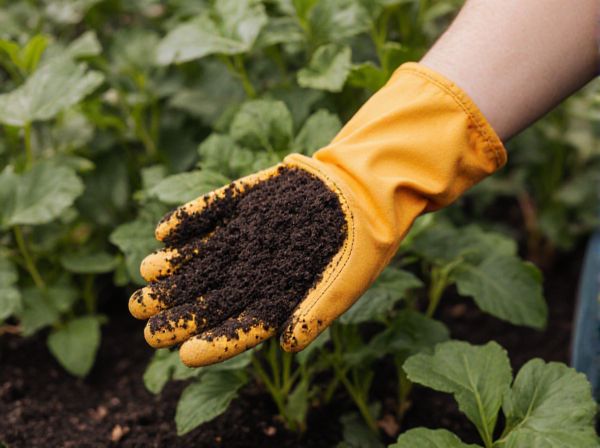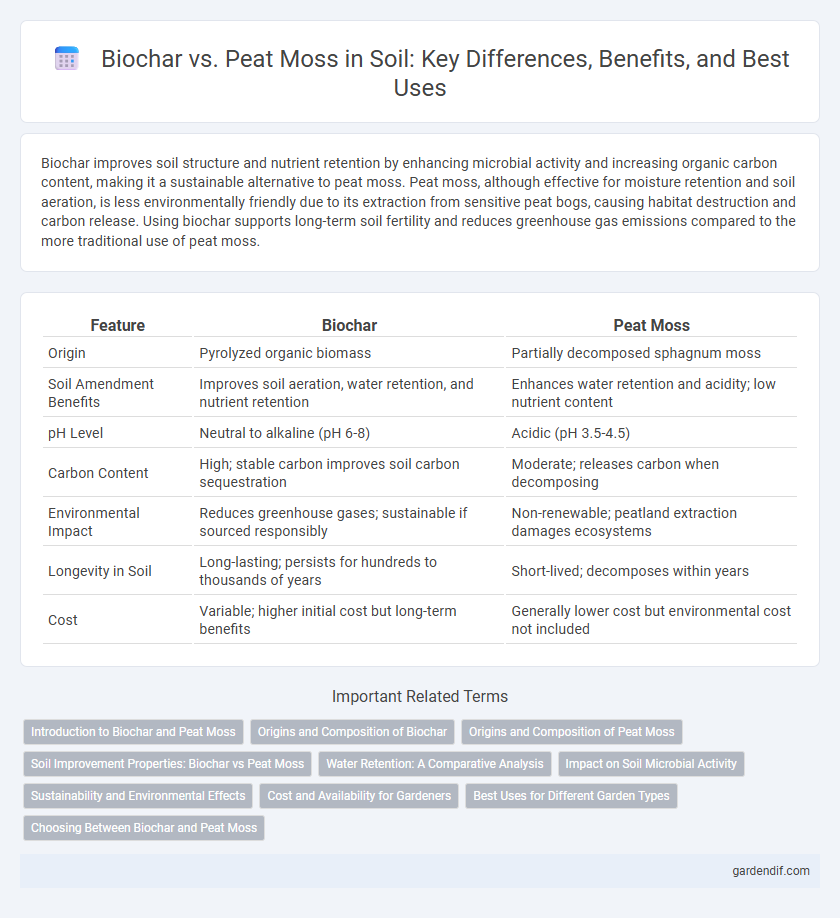
Biochar vs Peat moss Illustration
Biochar improves soil structure and nutrient retention by enhancing microbial activity and increasing organic carbon content, making it a sustainable alternative to peat moss. Peat moss, although effective for moisture retention and soil aeration, is less environmentally friendly due to its extraction from sensitive peat bogs, causing habitat destruction and carbon release. Using biochar supports long-term soil fertility and reduces greenhouse gas emissions compared to the more traditional use of peat moss.
Table of Comparison
| Feature | Biochar | Peat Moss |
|---|---|---|
| Origin | Pyrolyzed organic biomass | Partially decomposed sphagnum moss |
| Soil Amendment Benefits | Improves soil aeration, water retention, and nutrient retention | Enhances water retention and acidity; low nutrient content |
| pH Level | Neutral to alkaline (pH 6-8) | Acidic (pH 3.5-4.5) |
| Carbon Content | High; stable carbon improves soil carbon sequestration | Moderate; releases carbon when decomposing |
| Environmental Impact | Reduces greenhouse gases; sustainable if sourced responsibly | Non-renewable; peatland extraction damages ecosystems |
| Longevity in Soil | Long-lasting; persists for hundreds to thousands of years | Short-lived; decomposes within years |
| Cost | Variable; higher initial cost but long-term benefits | Generally lower cost but environmental cost not included |
Introduction to Biochar and Peat Moss
Biochar is a carbon-rich material produced through the pyrolysis of biomass, enhancing soil fertility by improving nutrient retention, water holding capacity, and microbial activity. Peat moss, harvested from decomposed sphagnum moss in wetlands, is widely used as a soil amendment for its excellent moisture retention and aeration properties. Both biochar and peat moss contribute to soil health, but biochar also offers long-term carbon sequestration benefits, making it a sustainable option for improving soil structure and fertility.
Origins and Composition of Biochar
Biochar is produced through the pyrolysis of organic biomass, such as agricultural residues and wood waste, under limited oxygen conditions, resulting in a stable, carbon-rich material. Unlike peat moss, which forms from partially decomposed sphagnum moss in waterlogged, anaerobic environments over thousands of years, biochar offers a more sustainable and rapid production method. Its porous structure and high carbon content enhance soil fertility and water retention, distinguishing it from the acidic, nutrient-poor composition of peat moss.
Origins and Composition of Peat Moss
Peat moss originates from partially decomposed sphagnum moss accumulated in water-saturated, anaerobic conditions over thousands of years, resulting in a lightweight, acidic organic material rich in carbon and low in nutrients. Its fibrous composition enhances water retention and aeration in soil, making it a popular amendment for improving soil structure. Unlike biochar, which is produced through pyrolysis of biomass, peat moss forms naturally in peat bogs, making its harvest ecologically sensitive and slower to replenish.
Soil Improvement Properties: Biochar vs Peat Moss
Biochar significantly enhances soil structure by increasing porosity and water retention, promoting beneficial microbial activity, and improving nutrient availability compared to peat moss. Peat moss primarily aids in moisture retention and acidity regulation but lacks the long-term carbon sequestration benefits that biochar provides. Biochar's stability and contribution to soil fertility make it a superior amendment for sustainable soil improvement.
Water Retention: A Comparative Analysis
Biochar significantly improves soil water retention by enhancing porosity and creating a stable, moisture-holding environment, outperforming peat moss in long-term water storage capacity. Peat moss absorbs water readily due to its fibrous structure but tends to decompose and lose water retention efficiency over time. Studies show biochar-amended soils retain up to 30% more water than those amended with peat moss, making biochar a sustainable alternative for drought-prone regions.
Impact on Soil Microbial Activity
Biochar enhances soil microbial activity by providing a stable habitat that improves aeration and moisture retention, promoting beneficial microbial populations and nutrient cycling. In contrast, peat moss has limited effects on microbial activity due to its low nutrient content and slow decomposition rate, often leading to reduced microbial diversity. Studies show biochar amendments can increase microbial biomass carbon by up to 30%, significantly surpassing the modest microbial stimulation observed with peat moss.
Sustainability and Environmental Effects
Biochar enhances soil fertility and carbon sequestration more effectively than peat moss, offering a sustainable alternative by reducing greenhouse gas emissions and improving soil health. Peat moss extraction contributes to habitat destruction and releases stored carbon, exacerbating environmental degradation. Utilizing biochar supports a circular carbon economy and promotes long-term soil resilience, making it a superior choice for sustainable agriculture.
Cost and Availability for Gardeners
Biochar tends to have a higher upfront cost compared to peat moss, but it offers long-term soil improvement and carbon sequestration benefits that may justify the investment for gardeners focused on sustainability. Peat moss is more readily available and generally less expensive at retail garden centers, making it a popular choice for immediate soil conditioning needs. However, concerns over peat extraction's environmental impact may influence availability and future regulatory constraints, potentially increasing costs for peat moss over time.
Best Uses for Different Garden Types
Biochar enhances soil fertility in vegetable gardens by improving nutrient retention and promoting beneficial microbial activity, making it ideal for high-yield crop production. Peat moss excels in acid-loving plant gardens such as blueberries and azaleas due to its naturally low pH and excellent moisture retention characteristics. For container gardening and seed starting, peat moss provides a lightweight, sterile medium, while biochar is better suited for long-term soil improvement in raised beds and orchard plantations.
Choosing Between Biochar and Peat Moss
Choosing between biochar and peat moss depends on soil goals and environmental impact priorities. Biochar, a carbon-rich product derived from organic waste, enhances soil fertility, water retention, and long-term carbon sequestration, making it ideal for sustainable agriculture. Peat moss improves soil aeration and moisture retention but raises ecological concerns due to its extraction from sensitive peatlands, affecting carbon emissions and biodiversity.
Biochar vs Peat moss Infographic

 gardendif.com
gardendif.com